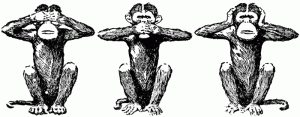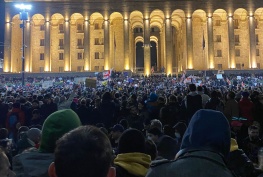The Three Wise Monkeys and Press Freedom
By Mugambi Mutegi
There are different meanings ascribed to the “Three Wise Monkeys” sculptures, depending on which part of the world you happen to be in.
In Japan, where the three – Mizaru, who is covering his eyes, Kikazaru, covering his ears and Iwazaru with his palms over his mouth – originated, they represent a “see no evil, hear no evil and speak no evil” maxim respectively.
Other cultures have used this adage as a swipe at people who do not call out wrongdoing happening around them.
I have always been fascinated by the three monkeys, who are also referred to as The Three Mystic Apes.
However, I probably should not have bought them in Kenya as a gift for Chicago Tribune Managing Editor Jane Hirt.
Two days after giving her a new set of three wood-sculpted monkeys, which she neatly arranged on her desk, my mind plunged into overdrive.
Would my choice of gift be erroneously construed as my take on the acclaimed newspaper? Why had I not thought about this prior to buying the three primates? Should I have bought her a sculpture of a lion instead? An elephant maybe?
Jane is a journalist after all; she is paid to look for the story behind the story.
I later shared my awkward logic with her. We laughed our hearts out and put a reassuring end to what had been a mental marathon for me.
That this happened a few days before Press Freedom Day was as coincidental as it gets, made worse by the fact that as part of my introduction to the Tribune, Jane asked me about how free the Kenyan media is.
I have had to answer this question on several other occasions, both inside and outside the newsroom.
My standard answer has been that I strongly believe the press in my country is free and that we have the liberty to report anything, about whomever and however controversial.
As long as you observe the journalism rule of thumb: stick to the facts.
As a journalist in Kenya, I have had to deal with one or two people who did not especially like an article in which I mentioned them or their companies negatively.
As is the case with reporters worldwide, you can prove your side of the story only if you have supporting documents or have the quoted person on record.
I have never been threatened with bodily harm, and I believe that is the rule and not the exception with my colleagues.
Some of the personal experiences that some of the fellows have shared with me have only cemented my view.
However, it has not always been rosy for Kenyan media.
Most of the major strides toward our current status were made during the tenure of the recently retired president, Mwai Kibaki.
Under his rule, the media became more critical of the government and corruption. They reported, and still do, anything they believed was not right.
Most importantly, they did this with a free hand.
Under the previous regime of President Toroitich Arap Moi, objective journalism was more restricted as the government had a more authoritarian, hands-on style of leadership.
I believe there are more gains to be made in Kenya, strides that can be made only if the professionals in this industry live up to their calling, keeping the public informed through a truthful and factual manner.
Indeed, if we see evil or hear it, we should be more than ready to speak about it and, in the case of print journalists, write about it.





